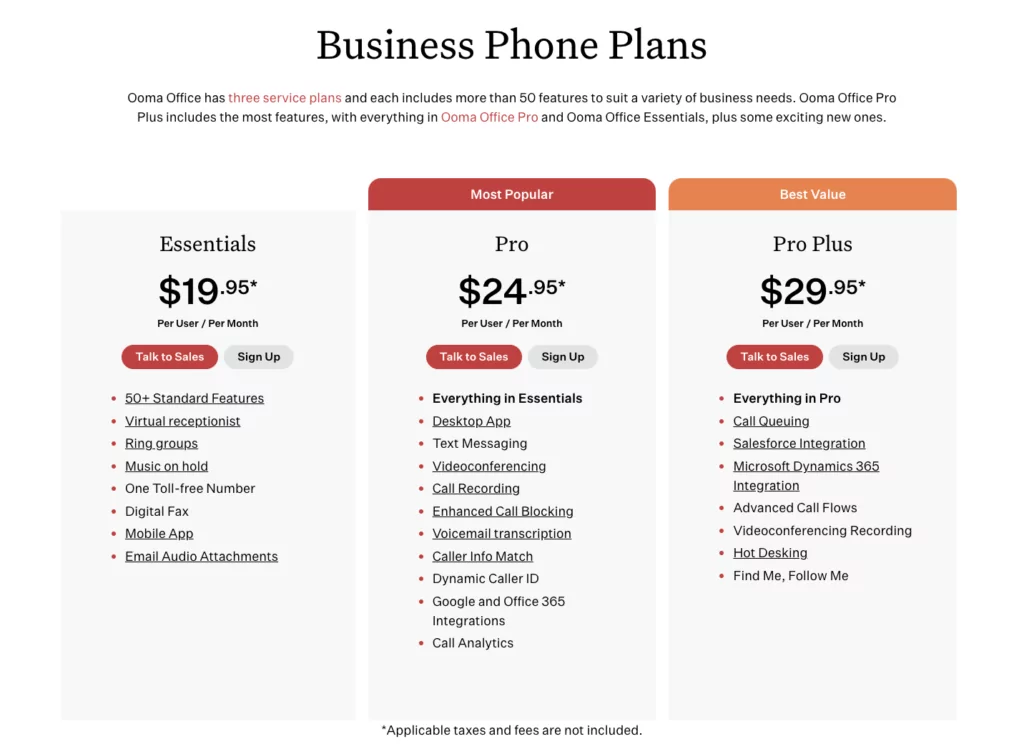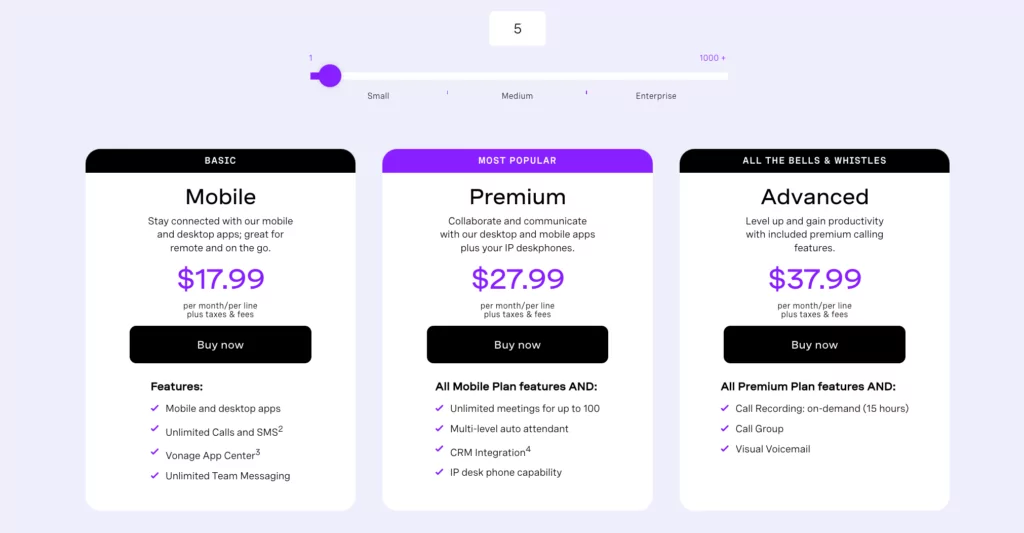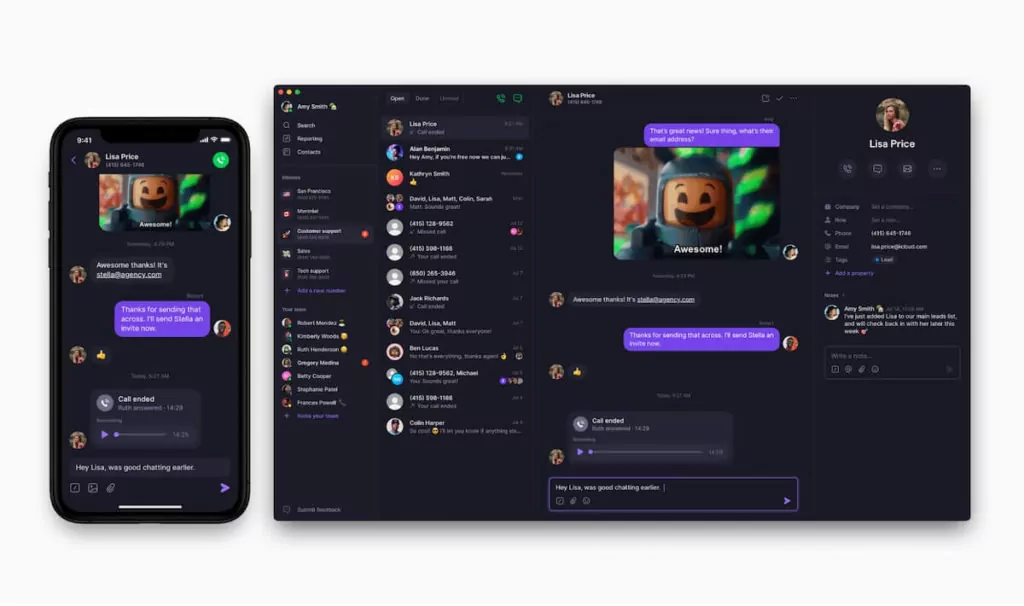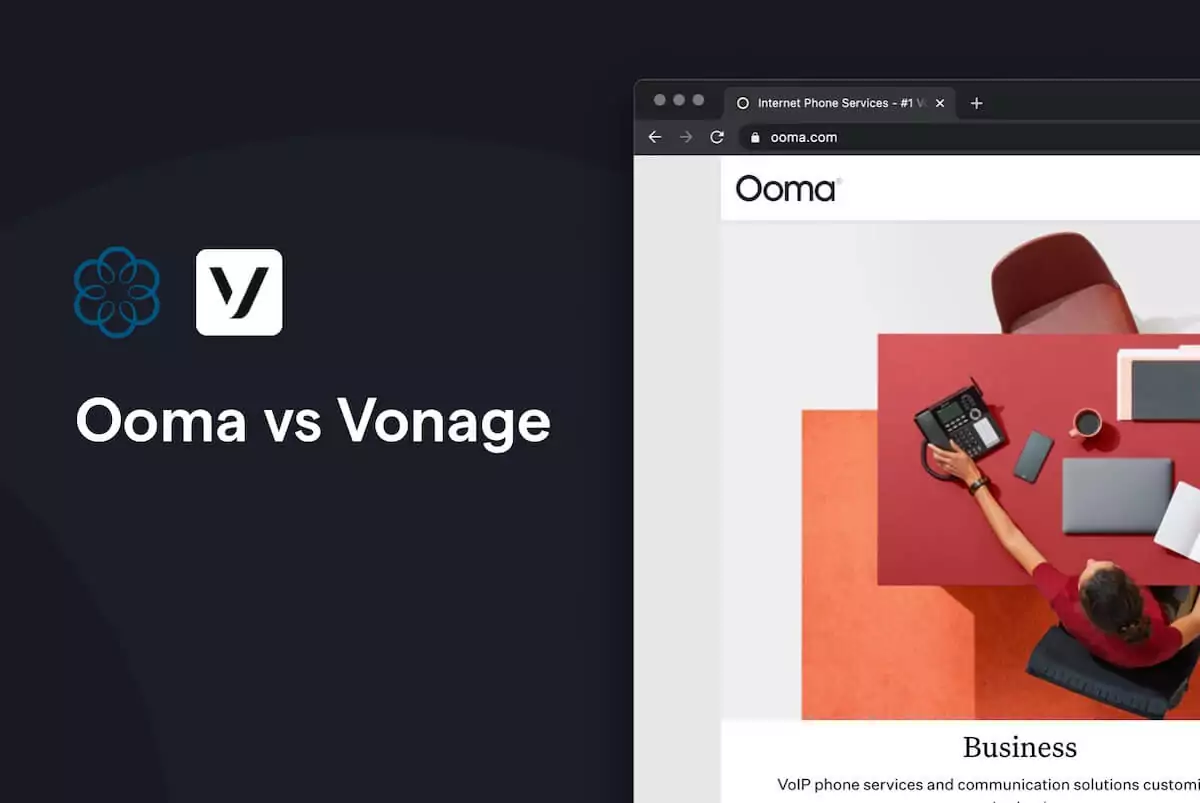Two of the industry’s leading competitors — Ooma and Vonage — were first on the scene of the business VoIP space. With similar plans, pricing, and features, it’s difficult to know which one to choose. Below, we dive deep into the Ooma vs Vonage debate to help you decide which option is right for you.
Which — spoiler alert — the answer happens to be “C: None of the Above.”
Ooma vs Vonage: How the two phone systems stack up
You know you need a business phone service, you just don’t know which one to choose. To settle any lingering disputes, we weigh the pros and cons of Ooma and Vonage below.
1. Pricing: Which service fits your budget?
Winner: Ooma
When it comes to weighing your options, there is no argument easier to settle than pricing. Here, it’s just a numbers game: Which cloud VoIP provider best benefits your bottom line?

Starting with the most basic plan, Ooma is far cheaper than Vonage … but it comes with a catch. While Ooma offers a basic plan at just $19.95 a month, that plan excludes some very basic features like voicemail transcriptions, text messaging, DND (do not disturb), call forwarding, and three-way calling.
Plus, the monthly plan doesn’t include startup costs, which runs between $99.99 and $129.99 depending on your plan (Ooma Telo Air or Ooma Telo White). If you need more features — which you surely do — you’ll need to upgrade to their Ooma Premier plan at $9.99 a month.

Vonage’s pricing depends on the size of your team with smaller teams paying more per user. For example, if you have a team of five, the Vonage basic plan will run you $17.99 a month and includes free unlimited calls, texts, and team messaging within the US. For more advanced features, like CRM integration, call recording, or group calling, your monthly fees spike to $27.99 or $37.99 per month for their premium plans.
Keep in mind also with Vonage, you must commit to a one-year contract on any of their plans.
2. Features: Which platform offers the best functionality?
Winner: Vonage
The largest advantage of a phone VoIP system is it’s so much more than a phone. With the right* provider (note the asterisk, because different providers come with different features 🙅), a VoIP system can create a shared voicemail inbox, offer call forwarding and caller ID, and easily connect your remote team.
When it comes to features, Vonage easily wins over Ooma. With 50-plus features, Vonage offers a business inbox, call forwarding, desktop, and mobile apps, cell phone integration, a second line, call routing, business SMS, voicemail, and voicemail to email. It makes remote work easier for teams — enabling do not disturb, call screening, and group texting. (Note: These features do vary slightly by plan.)
By comparison, Ooma offers a number of features that, frankly, you get from a regular phone service. Their “features” include 911, international calling (with extra fees), call blocking, voicemail alerts, and free calling to Mexico and Canada.
3. Integrations: Can your VoIP integrate with other services?
Winner: Vonage
Sales and customer support teams rely on VoIP services to make their jobs easier. To do this, cloud VoIP providers will (in theory) integrate with other platforms, like CRMs, email, and Slack.
Vonage integrates with a small collection of business apps, including Salesforce CRM, Google Workspace, Zendesk, Office 365, Slack, and Microsoft Dynamics CRM. They also work with Zapier, which offers integrations between apps.
Ooma Office offers several integrations, including Gmail, Dropbox, Amazon Echo, Salesforce, HubSpot, and Zoho.
4. Call quality: Which business phone system sounds the best?
Winner: Toss Up
If you’re debating between business phone service providers, you have to measure sound quality. After all, it’s difficult to conduct a prospect or client call unless you have high-quality sound and connection.
With that being said, it’s a toss-up between who wins on sound quality. Both Ooma and Vonage offer HD voice, which offers better quality than your standard desk phone. While the internet is filled with debates on which is actually best (some claim Ooma has fewer dropped calls, but this is nearly impossible to measure across platforms), the jury is still out on the winner.
Introducing option C: Why OpenPhone wins over Ooma and Vonage
When finding the best cloud VoIP provider for your business, there’s simply one option you need to weigh above Ooma and Vonage: OpenPhone.
OpenPhone works by adding a phone number to your existing mobile devices. In other words, your employees don’t need to lug around a business landline or extra SIM card. Your team simply selects a new phone number (or ports their existing one), downloads the OpenPhone mobile app, and then starts dialing and texting.
But that’s not everything. When it comes to comparing OpenPhone vs Vonage vs Ooma, OpenPhone wins in the aforementioned four categories.
1. OpenPhone gives you the most bang for your buck
OpenPhone requires zero startup fees, then starts at just $15 per month per user. For each additional phone number, it’s $5 a month. Plus, the Starter plan comes with a number of must-have features attached. You can place unlimited phone calls to anywhere in the US and Canada — plus get call forwarding, call waiting, auto-attendant, voicemail transcriptions, and group messaging. And you can place international calls (international rates apply).
And that’s not all … we just didn’t want to spoil the next section. 💪
2. OpenPhone offers the most features (easily)
To gain access to all OpenPhone features, you don’t need the frustrating task of setting up a new phone line. Instead, all you need is access to a Wi-Fi router or a data plan.
OpenPhone offers desktop and mobile apps, a business hours setting, shared phone numbers, a built-in CRM system, business SMS service, a shared inbox, call recording, and a number of integrations (discussed in the next section). Plus, OpenPhone offers auto-replies, making it easier for your team to text, respond to missed calls, and pretend they’re “always on” — even when they’re off.
3. It integrates with all the tools you love
OpenPhone integrates with Slack, Salesforce, HubSpot, and — wait for it — Zapier. Through Zapier, OpenPhone connects with 3,000-plus business apps, increasing productivity for your entire team. 👌
4. It offers beautiful sound quality
OpenPhone sounds great because it uses your existing mobile phone. You don’t need to worry about dropped calls or using a clunky landline. Instead, you get the same high-quality sound you expect from any other phone call.
Plus, OpenPhone makes it easier to manage your calls. You can easily set up auto-recording, so you can listen to previous calls. You can route calls to anyone on your team or easily transcribe messages and have them sent to your inbox.
In the Ooma vs Vonage vs OpenPhone Debate, There’s a Clear Winner

Cloud VoIP systems enable teams to work remotely and bring down phone operating costs. However, some systems are far superior to others.
While Ooma and Vonage were two of the first providers in the industry, they both come with several drawbacks. Ooma hardly offers any features you couldn’t get from a standard landline, while Vonage’s pricing is higher than what most small businesses can afford.
OpenPhone reinvents the business phone system, allowing your team to use their existing mobile devices. With a low monthly cost, automated replies, a long list of features, and 3,000-plus integrations, it’s the easy choice for a phone system.
So, what are you waiting for? See how OpenPhone can make your employees’ jobs easier, and sign-up for a seven-day free trial today.
FAQ
Ooma is slightly less expensive than Vonage, with the most basic plan from Ooma costing $19.95 per month. The most basic plan from Vonage costs $19.99 per month. With Vonage, you won’t be able to trial their platform — and you have to commit to a one-year contract. OpenPhone on the other hand has pricing that starts at $15 per user per month with all the must-have features included.
When it comes to features, Vonage offers more options (50-plus features) for businesses than Ooma. If you’re looking for a more intuitive option with just as many features, check out OpenPhone. With OpenPhone, you get access to desktop and mobile apps, a business hours setting, shared phone numbers, CRM integrations you can set up in just a few clicks, a business SMS and MMS service, and call recording.
Vonage offers more integrations in terms of sales platforms and CRMs. Ooma Office offers several integrations, including Gmail, Dropbox, and Amazon Echo. If you’re looking for a platform that integrates with the tools growing teams use, OpenPhone integrates with Slack, HubSpot, Zapier, and more.
